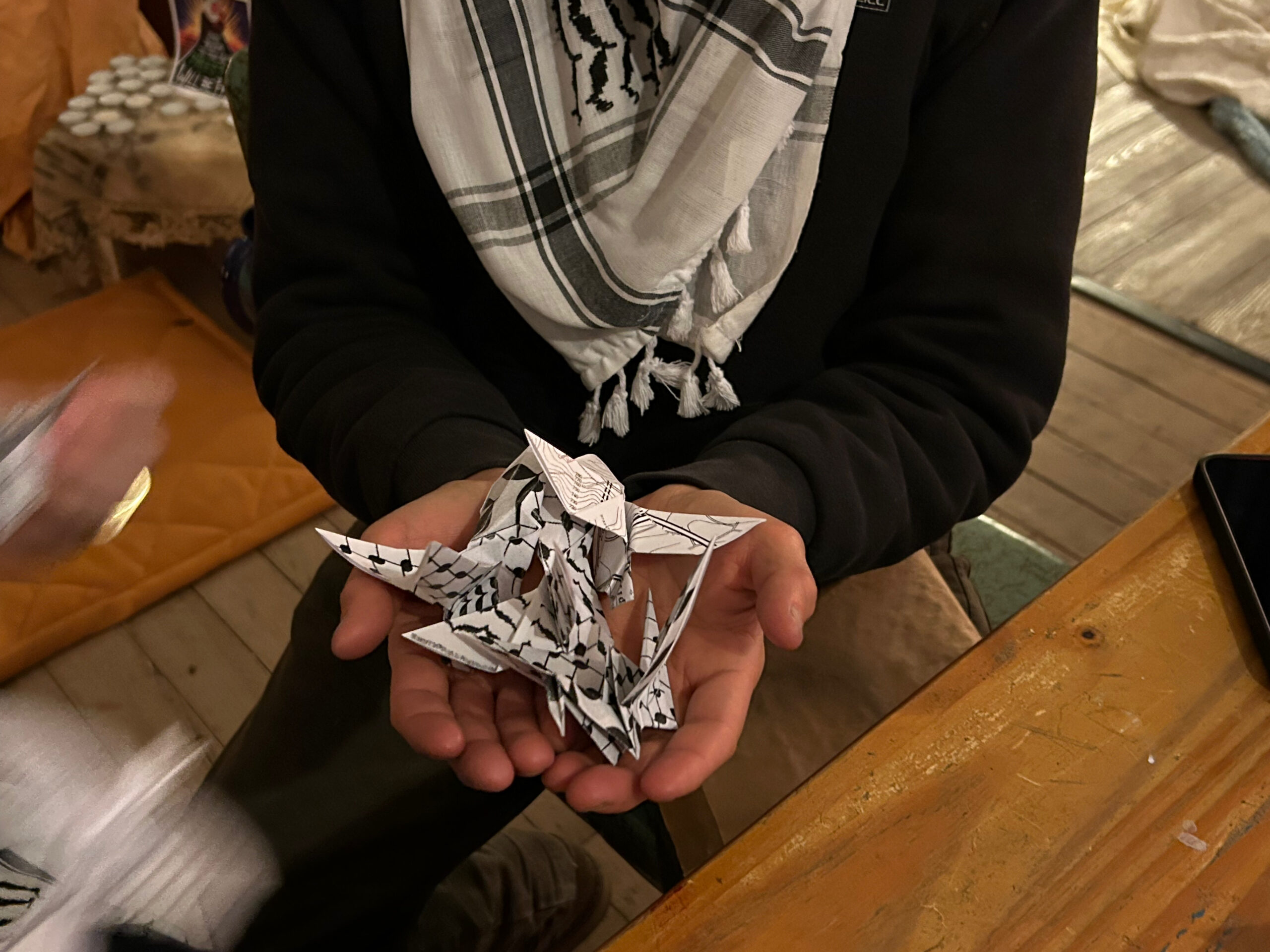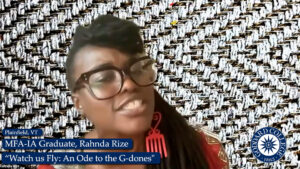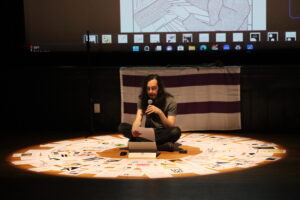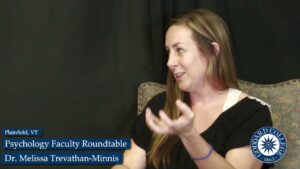March 13, 2019

This is the first installment of a three-part interview with Stefanie Batten Bland that was conducted by Reuben Radding on March 4, 2019 at New York University in New York City. Stefanie and Reuben are both current students in the Master of Fine Arts in Interdisciplinary Arts program at Goddard College. All photographs in the series are by Reuben Radding. — editor
STEFANIE BATTEN BLAND is a Choreographic Artist & Filmmaker.
Jerome Robbins awardee, she physically interrogates contemporary and historical cultural symbolism – and the complexities of human relationships. Her intercontinental dance-theatre Company SBB, formed in 2008 in France situates their work at the intersection of installation and dance-theatre in film and live performance settings. Currently, SBB is Movement Director at The Public Theater and a Choreographer for American Ballet Theatre’s Women Movement Initiative. She lives with her family in New York City.For more info: companysbb.org
REUBEN RADDING is a photographer, writer, and musician based in New York City. His award-winning street and personal documentary photographs depict elusive or unlikely candid moments, and intentionally provoke unanswerable questions in the viewer’s mind. Radding’s work has been exhibited in galleries around the world, and in publications like The New York Times, Rolling Stone, Hamburger Eyes, Time Out, Hyperallergic, Downbeat and others. His work has also been featured at the Miami Street Photography Festival, The Center for Fine Art Photography, and the Focus on the Story Festival. His first book of photographs, Apparitions, was published in 2013. Radding has been an instructor with the New York Institute of Photography since 2013, and has taught workshops or lectured at New York University, The School of Creative and Performing Arts, Marble Hill Camera Club, and others. Since 2017 he has offered a series of street photography workshops from his Brooklyn studio. He graduates from Goddard College with an MFA in Interdisciplinary Arts in July 2019.
REUBEN RADDING: Okay, something that has really stayed with me was, when I was at your company’s fundraiser, and you spoke very briefly at the end, you made a comment about using this work to explore what “personhood” was going to mean in the future. Can you talk about how the work you’re doing as a maker and teacher is asking that question and why it’s important to you?

STEFANIE BATTEN BLAND: I guess personhood means, to me, value first, so that someone feels valuable. I like to make work that makes us all feel like we have a reason, and, even better than a reason, we are the reason why we should be here. And, I guess as a maker and also the people that I work with, the minute I see people feeling validated in their self then I can tackle any storyline; I can tell any story that I need to tell. Alright, so I guess that’s from the maker side, when I’m working with employees or working with collaborators, like that.
I am a storyteller, I mean I don’t shy away from that. I love being able to tell stories that we can find ourselves in. I don’t know if they’re necessarily linear stories, but I think that’s another way that we can validate who we are, when we identify with someone, or with something, and I kinda like to go about it through a common goal. So I’ll often ask audience members and performers to work towards a goal, and that could be like lifting something up together…and we’ll go about it in a way that’s not going to…we’ll sneak it in on you in a way. So, you’re not going to this show thinking that “oh, I’m going to this show cause I’m having an immersive experience and I’m gonna be …” No, not necessarily––not at all! We’ll need your help with something. And actually, we won’t really know how the piece will end or what will occur with the next part. We actually don’t know what will happen if you don’t help us. So, we’re really extremely dependant on you participating with us to work towards this goal. Okay, so like in one piece it was helping us lift something really heavy up, and again the fact that I need your help is addressing you, not as the consumer that came and saw this show, but just as someone that needs to help your neighbor, and that really excites me because again it kind of makes that person feel valued. And what they can contribute to just the moment, right then and there, is extremely valuable.
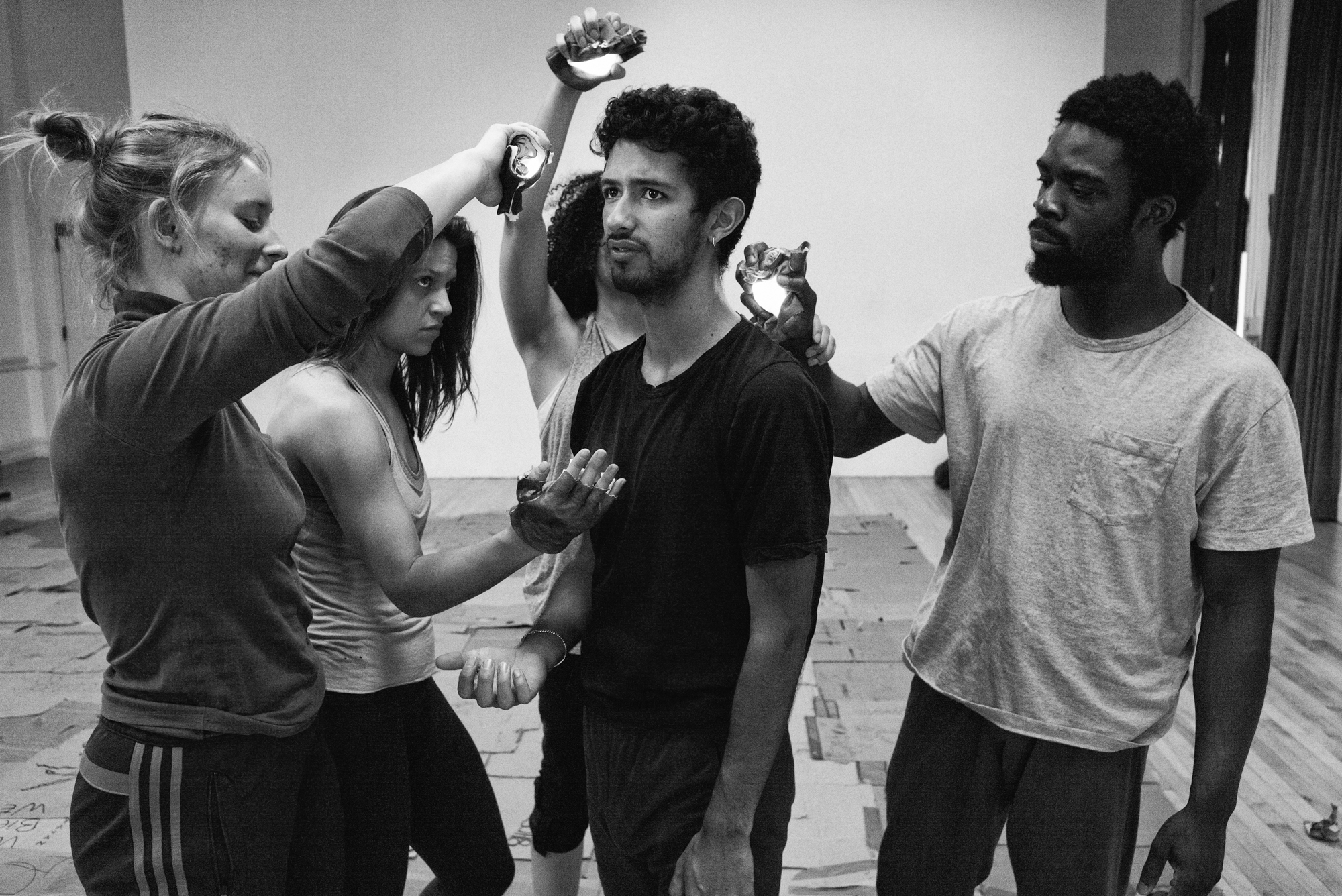
So all of these things––all of these acts––are supporting just a person’s self, and that’s something that in the genres that I’d performed in, wasn’t necessarily always the case. I mean that’s a wonderful image [indicates art on wall of ballet dancers] of what I mean, and that doesn’t capture it because it’s such an early era of the development of ballet that…So this is an illustration probably from like the 1800s or maybe 1700s of classical ballet and that by this time I think it’s probably moved into France. And it’s all wrapped up in the court system. And it must be a little bit later than that…and I do get a feeling from that that it’s about those individuals living that moment. And, I think by the time I came onto the scene we were really replicating shapes and replicating dynamics, and there might have been political motivations behind the pieces that I was part of but they were absolutely serving such a specific creator’s reasons, that I don’t necessarily know if I felt like I was valuable there. Anybody could have done that job. And, having had a lot of really important experiences in that kind of work, when I started making work, I got why collaborative making is the make-all end-all for me. Each one of these people is necessary to make what I want to make. So I realized that I make [pieces] more in a cinematic way; my casting is more specific to that story. Sometimes I’ll have crossover performers, but literally only if I know that they can help me [move] the story forward and what they’re going to bring to the table is going to make them feel and be so empowered, and feel really good about themselves. Cause a lot of the subject matter that I research and we perform is not necessarily blooming flowers and gorgeous sunsets! [laughs] So, I feel that I need to be with a team that is really proud, and content, and satisfied, and rooted in who they are, so that we can go to the depths of the dark pits of humanity to find reasons to hold hands.
I’d say as a teacher, the generation that I tend to be teaching, which are undergraduates…and they can be in a liberal arts college, or in a conservatory type program…they’re so caught up ––as any young person would be––in what they’re going to become, that there isn’t any anchoring in their personhood yet, and so I try to make exercises, or I try to invite them into an exercise space that will let them feel okay in exploring who that person is, and what is that person? And it’s okay if it’s not making this five-foot nine, 127 pound model. Uh, and I don’t mean “model” as in a model in a magazine––just like, that performative dance model that has been deemed as a successful look––for them to get through that they’re it! If that’s all you got to work with then that’s all you’ve got to work with, and that should be a marvelous it. So I try to bring them into a place where that’s supported, and let them see that the way the market is working now actually is more interested in people. And the more that I can help institutions graduate people that understand that they’re valued, again, as people, then the stronger the artmaking process is going to [be] from now until past my time and I’ll be leaving it in a strong place, you know. Of course it’ll be ready to evolve into whatever the next iteration is.
So, personhood: it’s really unique to the individual, and I hope it makes for storytelling that’s that much more complex and that we can actually relate to empathetically, as opposed to be wowed by technically, first. I love the idea, and work towards us being able to relate with a person, and then be wowed by them because we’ve gotten to relate to that person.
RR: When I saw your piece “Bienvenue” at LaMama, it seemed to be really important the way the audience was invited into the making, writing messages on the wall that would later have this key role in the dramatic climax of the piece, and it made me think about the breaking down of the traditional barrier of stage vs red plush seats, and I wondered how important that is to you? I mean we can talk about site-specific things and so on, but…
SBB: I don’t find it site-specific at all; I feel like we’re talking about Installation Artist 101. Like, I go back to my kid years, and all of these insane places I would go to, just because that [Soho] was our neighborhood, and these lofts that were made into these enormous worlds (and I should probably be having a psychotic breakdown as I understand), I literally grew up walking through like, Ann Hamilton’s world, you know, and not knowing it, just like “there’s more dirt.” You know? [laughs] Like, “okay Mom, we’re going to touch dirt again today,” [laughs] you know, or whatever! But, the impression and the delight that I think I got to have as a kid, I want other people to be able to have that, and that was through a really specific word: it was through the invitation. And to me, really great installation art is something that intrigues the person to want to interact with it, or if they don’t they’re getting exactly what they need to be getting from it as well, and that is 100% exactly what they should be having. Whereas I’ll say immersive work is…the relationship has to fulfill, or get to certain quotas so that scenes can move forward, and in installation art, no, the thing’s on display. It can be activated, it can have a life. So this idea of invitation is really important to me. In all of our pieces I want the spectator to be able to feel that thanks to them something is going to happen later, that thanks to them, they now understand why they were there all this time before. I normally put our participatory options either at the very beginning of the piece, or at the very end. I haven’t yet explored somewhere in the middle, and I can tell that I’m starting to get ready for that now, which is interesting, but I guess I’ve always worked up till now (I mean I’ve only got a few pieces under my belt), but I felt that the beginning and the end the most chaos could occur and it could still be corralled into a successful performance…and we’ve got, “okay, well, if this happens we can do A, B, C, we can react in these various ways.” So, yeah, you’re right, and hey, we’re in a traditional procenium format at LaMama, I mean like we had seating on the sides, but still…we were in elevated levels, we had the beautiful downpour [sic] viewing for spectator and to the pit where the action was; coliseum seating, right? So what was really exciting, was to watch people put their things down, sit down, and then see them see other people just like them, who were, for whatever personality reasons, getting up and going down…and the actual decision making going on for them corporally, is so exciting to me. As you can see that they realize they’re in a place where they can let it all loose and be crazy, you know get up and go get a pen, or that might be what sets the fear of God in them! [laughs] You know, and so they just want to sit down and watch that, and how fascinating that looking becomes. And it’s not just looking, consuming something, they’re looking at something, realizing that they could be doing it, but they’re not.

RR: They know they were invited.
SBB: They know that they were invited, and that’s just the most wonderful thing.
RR: Not just invited to buy a ticket.
SBB: Exactly! You don’t have to eat the birthday cake. You know it’s there for you to take a slice. It’s probably got good frosting. [laughs] I love that act of inviting. It think that’s just the most wonderful thing we can do in life, because you’re not being told, you’re not being scolded, and you’re right…with Bienvenue we use words. In A Place of Sun we never use words. In Bienvenue our script is very tight. And you know, we welcome you into the space first, so already that is like this humbling…coming into a shared space together place, right? And it’s probably the thing we worked the most on, because it’s so hard to achieve with genuine authentic…you know, and not…I’m not going to project [uses announcer-type voice] “YOU’RE WELCOME INTO MY SPACE” with that glossy horrible voice that comes on that should be saved for the next season of Mad Men; that will never happen. You know what I mean? Like, In A Place of Sun we didn’t use voice at all, which is amazing because in A Place of Sun we were working with these huge sphere baskets. Same visual collaborator, Benjamin Heller, and these enormous spheres, or they are our cradles, they are also kind of cage-like, they’re egg-like, they were world-like, they’re nest-like, and we needed the audience members to help carry them with us, and we just got really low, and it was all about bodily composition. People were seated in their seats, and we literally have to get lower than them so that we don’t feel a power confrontation going on and that they can understand that we actually need their help, and so we’re struggling to––literally, cause they’ve been dancing for fifteen minutes and everybody’s exhausted [laughs] and you know trying to lift these huge things––and people just…they GET IT, they’re like “oh my God you need help!” And the thing just happens! And it’s the most wonderful…so in that case the invitation was “could you help me?” And in that place, everyone always said, “yeah. Yeah I can help.” You know. Invitation is everything.
•••
The Master of Fine Arts in Interdisciplinary Arts (MFAIA) program at Goddard College is a unique graduate experience at the intersection of contemporary art practice and Goddard’s landmark method of low-residency, human-centered learning and teaching.

